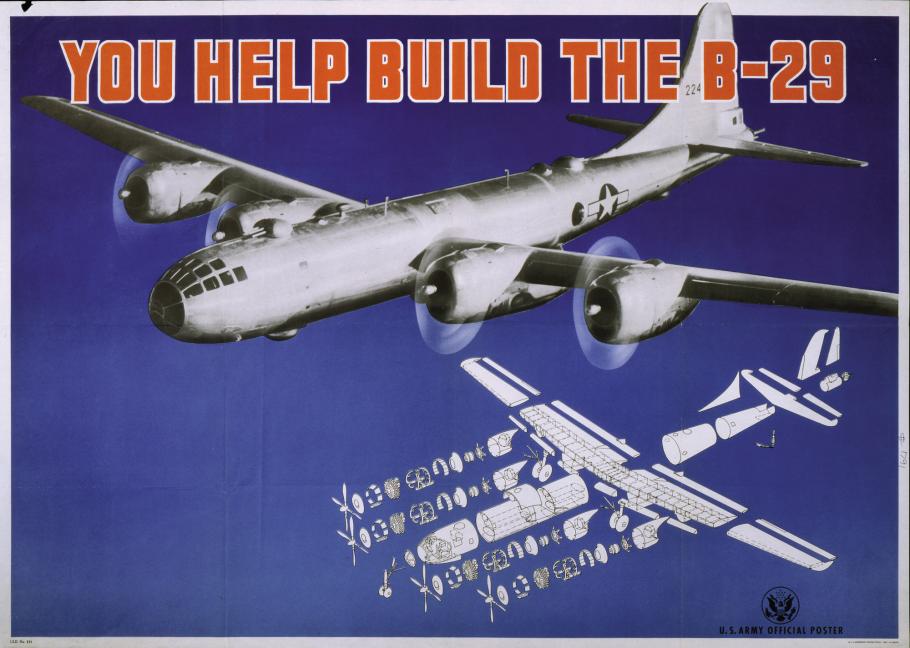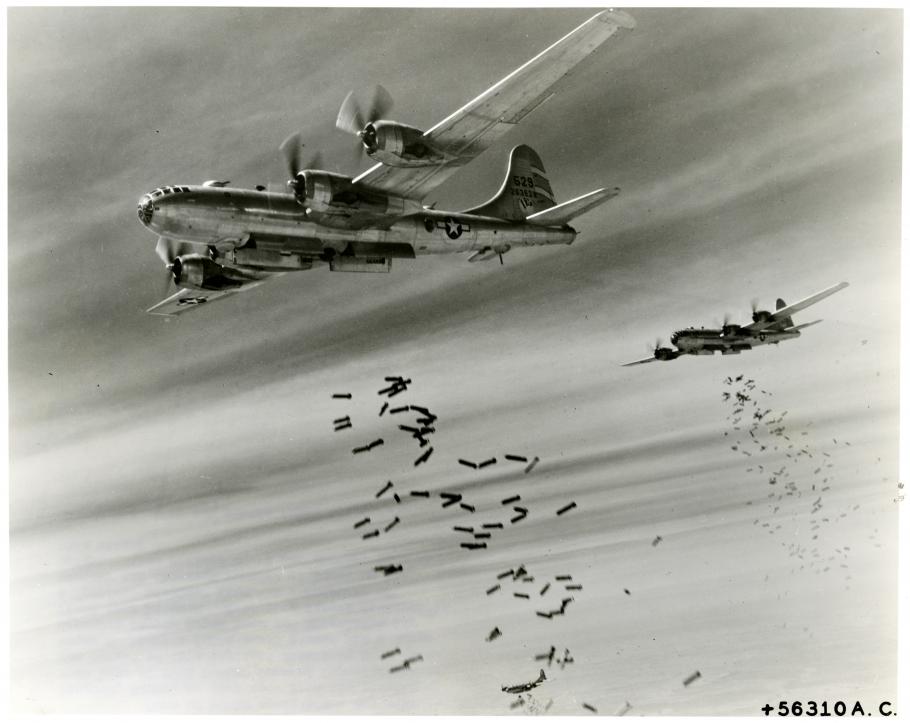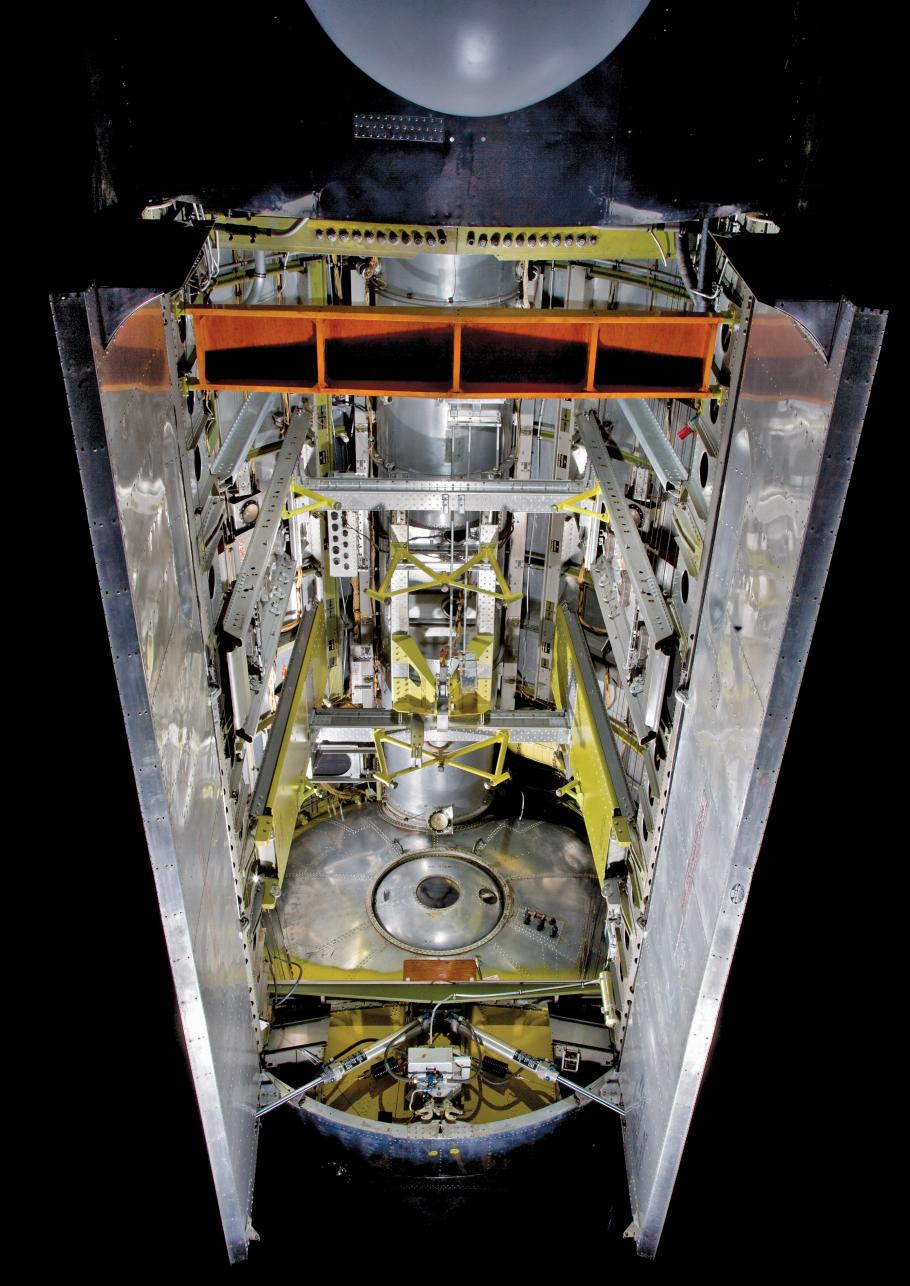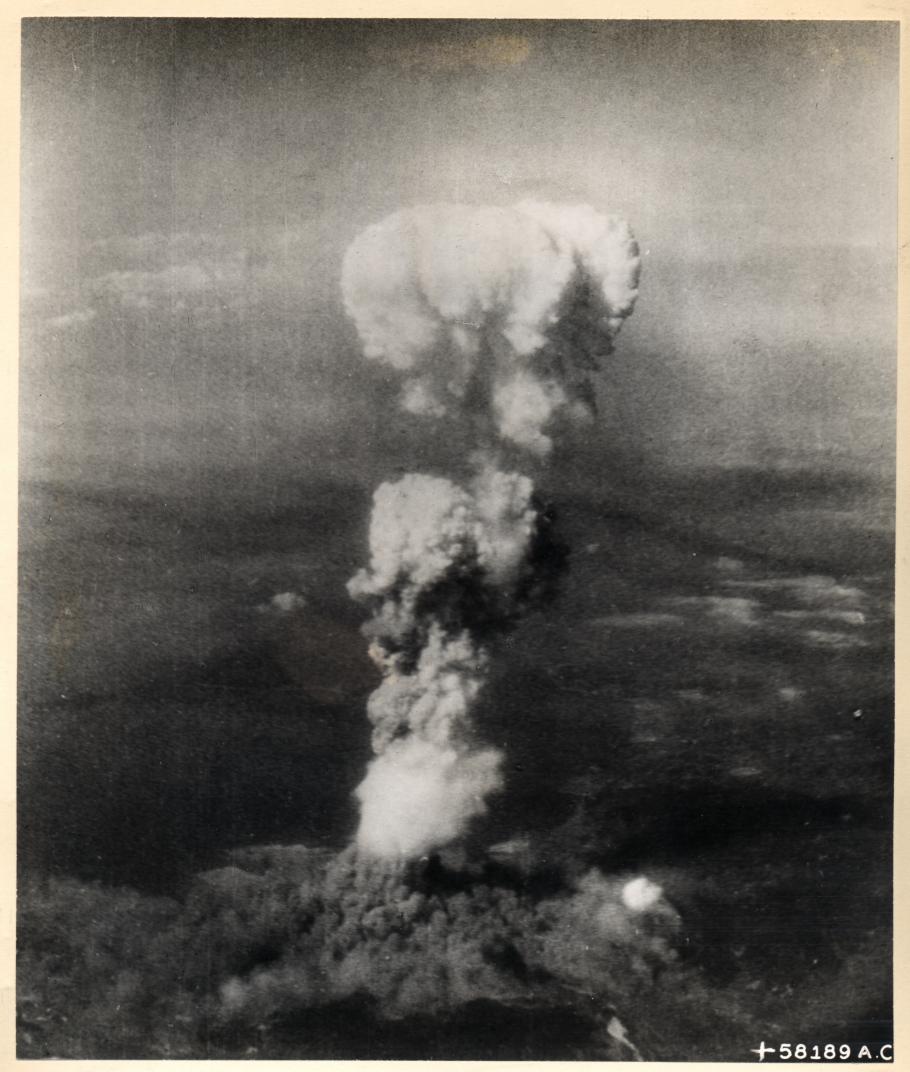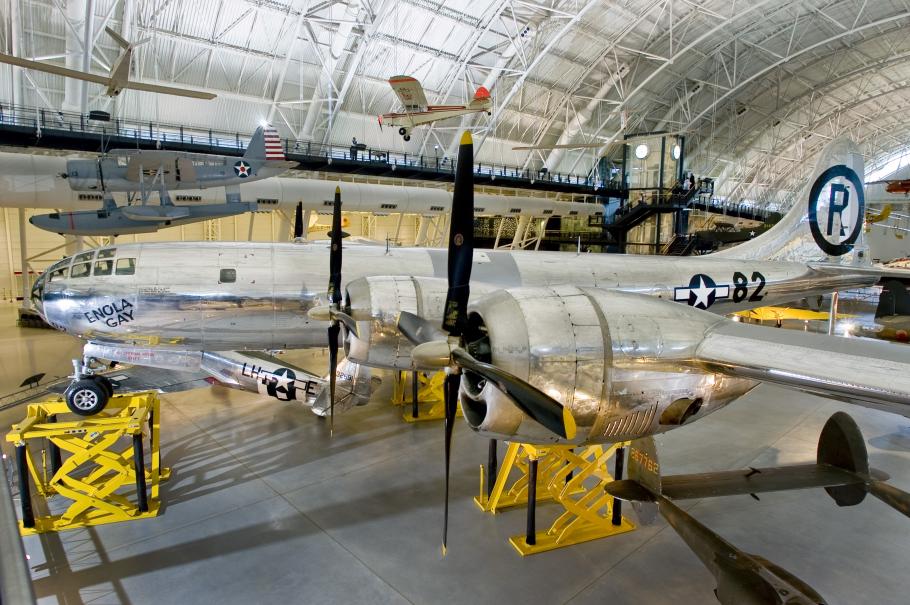On August 6, 1945, the crew of a modified Boeing B-29 Superfortress named Enola Gay dropped the first atomic bomb used in warfare, called “Little Boy,” on the city of Hiroshima, Japan. Another atomic attack on Nagasaki followed three days later. The delivery system for these bombs, the Superfortress, represented the latest advances in American aeronautical engineering and bomber design, and its use in the skies over Japan reflected the evolution of strategic bombing doctrine. As a new and deadly weapon, an atomic bomber, Enola Gay facilitated a turning point in human history as it ushered in the dawn of the Atomic Age and the threat of nuclear war.
The Boeing B-29 Superfortress was the most advanced propeller-driven airplane in the world in 1945, making it the ultimate definition of a “modern” airplane. Designed to fly farther, faster, and higher than any other bomber, the combination of the B-29’s aerodynamic, structural, and propulsion innovations allowed it to carry 5,000 pounds of bombs to a target 1,500 miles away while cruising at 220 miles per hour at altitudes up to 30,000 feet. It also had advanced tricycle landing gear and was the first bomber to have an analog computer-controlled defensive armament system and a pressurized and heated fuselage that meant the 11-person crew did not have to wear oxygen masks and heavy, bulky clothing during long missions.
The nationwide effort to manufacture the technologically-sophisticated B-29 included factories in Washington, Kansas, Nebraska, and Georgia turning out complete aircraft and thousands of sub-contractors producing smaller components and equipment.
After a long and challenging development phase, the B-29s of the 20th Air Force went into combat against Imperial Japan in June 1944 from bases in India and China and in November 1944 from the Mariana Islands. The failure to achieve results with daylight, high-altitude, precision bombing in the unique operational environment over Japan led to a switch to low-level, nighttime, firebombing raids. The 20th aimed to destroy Japanese industry and kill or drive away its workers by burning the mostly-wood cities to the ground. Approximately 300 B-29s attacked Tokyo in March 1945, killing upwards of 100,000 people and destroying one-fourth of the city in a single 24 hour period. Additional raids on selected targets and the aerial mining of shipping lanes effectively left Japan isolated and in military, economic, political, and social shambles by the end of July 1945. The 20th’s campaign came at a cost of over 500 B-29s lost in combat or operational and training accidents with their crews either killed, injured, missing-in-action, or becoming prisoners-of-war.
B-29s dropping bombs on Japanese-held targets near Rangoon, Burma in February 1945.
As the American strategic bombing campaign reached its crescendo against Imperial Japan, the United States was developing a new weapon. The atomic bomb program, centered on the government laboratory at Los Alamos, New Mexico, was equal in size, scope, and secrecy to the B-29 program. After a successful test explosion in July 1945, the United States had a new weapon to use against Japan and to affect a rapid end to the war. There were two types of bombs used against Japan: a uranium-235 gun-type fission weapon called “Little Boy” and a plutonium, implosion-type called “Fat Man.” The codenames referred to their shapes, the former small and compact, and the latter large and rotund.
To deliver the new weapon, the U.S. Army Air Forces created the world’s first atomic bombing force, the 509th Composite Group, in December 1944. It was under the command of Col. Paul W. Tibbets, Jr., a battle-hardened B-17 veteran of Europe. He chose his fellow 8th Air Force veterans, bombardier Maj. Thomas Ferebee and navigator Capt. Theodore “Dutch” Van Kirk, to join him to lead the group. The 509th’ underwent intensive training in the United States and in the Pacific for one specific mission: the delivery of an atomic bomb from the air.
Custom Image Caption
Left to right, pilot Paul Tibbets’ and bombardier Tom Ferebee’s positions in Enola Gay.
Custom Image Caption
Navigator Dutch van Kirk’s position in Enola Gay. The pilot’s position is on the other side of the bulkhead.
Design work began on the modification of the B-29 into an atomic bomber under the Silverplate project in June 1943. Silverplate B-29s had no armor plate or upper and lower fuselage turrets, which reduced the total weight of the aircraft by 7,200 pounds. The installation of reversible Curtiss Electric propellers enabled the use of backwards thrust to slow the lumbering bomber down on the runway if it had to land with the bomb. The forward bomb bay and forward wing spar required modification to accommodate a single bomb that would weigh in the area of 10,000 pounds. To that end, they adopted the British Type G single-point attachments and Type F releases that the British used on the Avro Lancaster bomber to carry the 12,000-pound Tallboy earthquake bomb. Overall, the changes made to the B-29 enabled the modified bomber to carry an atomic bomb while cruising 260 mph at 30,000 feet.
Bomb bay of the B-29 Superfortress Enola Gay, which dropped the first atomic bomb used in warfare on Hiroshima on August 6, 1945.
Production of the first 15 Silverplate B-29s for the 509th took place at the Glenn L. Martin Factory in Omaha, Nebraska. Paul Tibbets personally selected one of them to be his operational aircraft on May 9, 1945. The Army Air Forces received the B-29-45-MO with the serial number 44-86292 on May 18 and the 509th assigned it to crew B-9 commanded by Capt. Robert A. Lewis. They arrived at Wendover, Utah, for training and practice bombing on June 14. They departed for Tinian by way of Guam on June 27 and arrived on July 6. Soon after, personnel added the “Circle R” symbol of the 6th Bombardment Group of the 20th Air Force on both sides of the vertical tail and the number “82” just behind the bombardier’s window position to confuse enemy intelligence.
On Tinian, the 509th was under the operational control of the 20th Air Force headquartered in Washington, D.C. It issued Special Bombing Mission Number 13 on August 2, which designated the city of Hiroshima as the target for the 509th. On August 5, Tibbets took command of 44-86292 and ordered the name “Enola Gay” be painted on the left side of the aircraft under the pilot’s window in honor of his mother.
The flight crew of the Enola Gay with ground maintenance officer, Lt. Col. John Porter (standing far left). Left to right, standing: Capt. Theodore J. "Dutch" Van Kirk, navigator; Major Thomas W. Ferebee, bombardier; Col. Paul W. Tibbets, pilot; Capt. Robert A. Lewis, co-pilot; and Lt. Jacob Beser, radar countermeasure officer. Left to right, front row: Sgt. Joseph S. Stiborik, radar operator; Staff Sgt George R. “Bob” Caron, tail gunner; Pfc. Richard H. Nelson, radio operator; Sgt. Robert H. Shumard, assistant engineer; and Staff Sgt. Wyatt E. Duzenbury, flight engineer. The other two individuals that participated in the flight, weaponeer and mission commander, Capt. William S. Parsons of the U.S. Navy, and his assistant, 2nd Lt. Morris R. Jeppson, are not pictured.
Custom Image Caption
Enola Gay at Tinian after the atomic mission against Hiroshima on August 6, 1945.
Tibbets and his crew took off from Tinian in Enola Gay at 2:45 am on August 6, 1945. Dutch van Kirk plotted the 1,500 mile route from Tinian to Hiroshima. Weaponeer and mission commander Capt. William S. Parsons of the U.S. Navy activated the bomb during the flight and his assistant, 2nd Lt. Morris R. Jeppson, inserted the arming plugs 30 minutes before reaching the target. Upon visual location of Hiroshima, Tom Ferebee aimed for the city center and Enola Gay dropped the “Little Boy” bomb from 31,000 feet at 9:15 am. Radar operator Jacob Beser tracked the bomb as it fell 43 seconds to its predetermined detonation height of approximately 2,000 feet over the city center. The explosion of the uranium bomb, which was equal to 15 kilotons of TNT, and the resultant firestorm killed an estimated 135,000 to 200,000 people, destroyed 4.7 square miles of the city, and left less than 20 percent of the city’s buildings standing.
After “Little Boy” left the forward bomb bay, Enola Gay lurched upward, and Tibbets initiated a high angle evasive maneuver to get as far away from Hiroshima as possible. A bright flash overwhelmed the senses of the crew. The bomber traveled 11.5 miles before it experienced the shock waves from the atomic blast. Staff Sgt. George R. “Bob” Caron in the tail gun position took a photograph of the mushroom cloud over Hiroshima. Radar operator Sgt. Joe Stiborik recalled the crew was speechless overall. Robert Lewis wrote in his journal and may have subconsciously said out loud over the radio intercom, “My God, what have we done?” Enola Gay landed back at Tinian 12 hours later at approximately 3 pm.
Enola Gay tail gunner Bob Caron took this picture of the cloud of smoke billowing 20,000 feet above Hiroshima after the explosion of the Little Boy atomic bomb on August 6, 1945.
The crew of another B-29, Bockscar, dropped a Fat Man plutonium bomb on Nagasaki, Japan, three days later on August 9. The Soviet Union declared war and invaded Japanese-held Manchuria the same day. Facing Allied invasion and the threat of continued incendiary and atomic bombings, on August 15, Emperor Hirohito, in an unprecedented radio address to the empire, announced the Japanese government’s intention to surrender. A formal ceremony followed aboard the battleship U.S.S. Missouri, anchored in Tokyo Bay, on September 2, 1945, which became known as Victory Over Japan Day, or V-J Day, in the United States. World War II, the bloodiest conflict in human history, was over.
The history and memory of Enola Gay and its part in the atomic attacks on Japan, and their effect on ending the war in the Pacific and the nuclear tensions of the Cold War, reflects differing viewpoints. Many, especially the generation of Americans that fought in World War II and their families, saw the use of atomic bombs against Japan as a means to shorten the war and to prevent a large-scale invasion that would have resulted in the unnecessary loss of lives on both sides. Others, including survivors of the atomic bombings and peace and anti-nuclear activists, have questioned the United States government’s rationale for using atomic weapons against Japan and the world’s continued reliance on nuclear weapons in national defense that followed during the Cold War and on into the twenty-first century. Almost all recognize the terrifying legacy of power and responsibility created by the availability of what would be commonly referred to as “the Bomb” and the hope that one will never be used again in war.
The Smithsonian has been at the center of debates over those differing perspectives in terms of the interpretation and public display of Enola Gay. After being transferred from the U.S. Air Force in the late 1940s, Enola Gay remained in storage for decades. Museum staff began the restoration of the aircraft in December 1984 with the intention of it being displayed at some point in the future. Enola Gay was to be the central artifact in a planned exhibition at the Museum examining the atomic bombings during the 50th anniversary of the end of World War II. Tensions resulting from different historical perspectives of those events erupted into a nationwide controversy that led to the Smithsonian’s cancellation of the exhibition in early 1995.
Boeing's B-29 Superfortress was the most sophisticated propeller-driven bomber of World War II, and the first bomber to house its crew in pressurized compartments. The Boeing B-29 Superfortress Enola Gay is now on display at the Steven F. Udvar-Hazy Center.
This exhibition was on display in Gallery 103 from June 28, 1995 to May 17, 1998.
In a revised exhibition, Enola Gay’s forward fuselage and bomb bay, two engines, a propeller, and other components, including a deactivated Little Boy bomb, went on display in the National Mall Building from June 1995 to May 1998. When the Museum’s Steven F. Udvar-Hazy Center opened in December 2003, the fully-assembled Enola Gay went on permanent display in the World War II Aviation display area in the Boeing Aviation Hangar. The display of the Enola Gay has generated a variety of responses ranging from public protests in 1995 and 2003 to opposing points of view expressed in alternative exhibitions, petitions, and reports, and continues to serve as a case study in presenting history in the public sphere that is vigorously discussed and debated to this day.
Enola Gay on display in the Boeing Aviation Hangar of the Steven F. Udvar-Hazy Center.
The flight of the Enola Gay on August 6, 1945, signifies an end and a beginning in terms of our evolving understanding of technology and warfare in the twentieth century. It is part of the story of the final victory over Imperial Japan and reflects the dedication and sacrifice of the American military and industrial war machine that helped win the war overall. It also became the ultimate example of how aeronautical technology, normally celebrated to a high degree before the war as a positive force in history, could also symbolize the utter destruction of humankind itself. It is hard to disassociate two triumphs of American technology—the modern airplane and atomic energy—from the chilling fact that one B-29 with one atom bomb destroyed an entire city in August 1945, which was repeated only days later by another B-29. Those events forever changed how the world approached warfare and created a nuclear legacy that is still with us today.
Jeremy Kinney is the Chair of the Aeronautics Department and curator for American military aviation, 1919-1945.
